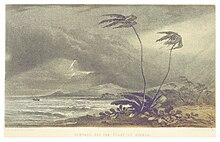
Archeological digs suggest a settlement existed on the northern bank of the Merbok River by the 1st millennium CE. The Merbok settlement, Sungai Batu was built near the river's estuary.[1][2] The early history of Kedah can be traced from various sources, from the prehistoric period, most famously the archaeological site of Bujang Valley, the early maritime trade of India, Persia, and the Arabs to the written works of early Chinese pilgrims and early Chinese records, and later to the partly-historical Hikayat Merong Mahawangsa and the Al-Tarikh Salasilah Negeri Kedah.
Around 170 CE groups of people of the Hindu faith arrived at Kedah, joining them soon were peoples from nearby islands and those from the northern Mon-Khmer region. Traders from India, Persia and Arabia arrived in the Malacca Strait, using Gunung Jerai as a landmark point in their travels.[3]
| History of Malaysia |
|---|
 |
|
|
After the 7th century, Srivijaya gained Kedah as one of its vassals. In trade, Kedah supplied its own tin, and jungle products such as rattan, resin, honey, beeswax, elephants, ivory, areca nuts, Sepang wood and black woods, as well as profiting from tax collections. Kedah was Islamised in the 15th century (another tradition states the year 1136 CE) and then fell under the sway of Malacca, then later under Ayutthaya. After trading away Penang in 1786, Kedah was embroiled in an invasion from Siam in the 1820s. Kedah was then transferred to Britain under the Anglo-Siamese Treaty of 1909 and remained under British Malaya until gaining independence as part of Malaysia in 1957.
- ^ "Sg Batu to be developed into archaeological hub". The Star. 3 October 2020. Retrieved 8 November 2020.
- ^ "FIVE REASONS WHY YOU MUST VISIT THE SUNGAI BATU ARCHAEOLOGICAL SITE AT LEAST ONCE IN YOUR LIFETIME". Universiti Sains Malaysia. 14 November 2019. Archived from the original on 17 June 2021. Retrieved 8 November 2020.
- ^ A concise history of Islam. Ḥusain, Muẓaffar., Akhtar, Syed Saud., Usmani, B. D. New Delhi. 14 September 2011. p. 308. ISBN 9789382573470. OCLC 868069299.
{{cite book}}: CS1 maint: location missing publisher (link) CS1 maint: others (link)